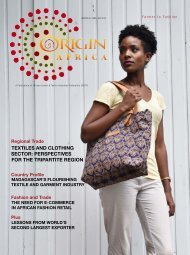Create successful ePaper yourself
Turn your PDF publications into a flip-book with our unique Google optimized e-Paper software.
West <strong>Africa</strong><br />
embarks on a programme to<br />
adopt HVI testing as the method of<br />
choice when it comes to classing<br />
cotton.<br />
It is within this environment that<br />
the Quality Control Division of<br />
Cotton SA can offer an essential<br />
service and provide a complete<br />
quality profile of the cotton tested,<br />
allowing spinners to use their cotton<br />
on a more cost efficient basis.<br />
HVI fibre testing also provides<br />
useful information to seed breeders,<br />
enabling them to produce<br />
cotton cultivars with characteristics<br />
desired by the spinning industry. Instrument<br />
testing also enables cotton<br />
producers and ginners to sell<br />
their cotton based on reliable and<br />
internationally accepted results. It<br />
enhances the price fetched on the<br />
market and subsequently leads to<br />
improved market access. It goes<br />
without saying that it is essential for<br />
producers, processors and traders<br />
to know exactly what the processing<br />
performance and the quality of<br />
the fibres they are dealing with, are.<br />
Training and transfer of<br />
technology<br />
Against the background of its<br />
accepted credibility in the cotton<br />
industry, the Quality Control Division<br />
is also ideally positioned to<br />
present training courses pertaining<br />
to fibre testing and technology<br />
including the grading and classification<br />
of cotton. These training<br />
courses have successfully been<br />
presented for many years not only<br />
to South <strong>Africa</strong>n role-players but<br />
also to participants from various<br />
other countries in <strong>Africa</strong>. Cotton<br />
SA is currently in the process to<br />
expand its training curriculum to<br />
also include the interpretation of<br />
the HVI results and how to use this<br />
as a tool in the marketing or further<br />
processing of cotton.<br />
Evolution and Outlook for the<br />
Cotton Sector in the CFA Zone<br />
BY GÉRALD ESTUR<br />
Gérald Estur<br />
Overview of the Cotton Sector<br />
in the CFA Zone<br />
Cotton is produced in 11 out of the<br />
14 countries of the <strong>Africa</strong>n Franc<br />
Zone which including Benin, Burkina<br />
Faso, Cameroon, Central <strong>Africa</strong>n<br />
Republic, Chad, Côte d’Ivoire, Guinea<br />
Bissau, Mali, Niger, Senegal and<br />
Togo. The zone accounts for more<br />
than half of the total cotton output in<br />
<strong>Africa</strong>.<br />
The “white gold” is a vital cash crop<br />
for smallholder farmers, providing<br />
employment and incomes to millions<br />
of people. It contributes to poverty<br />
alleviation and food security and is an<br />
important source of foreign exchange<br />
earnings.<br />
Production is labor intensive, using<br />
manual or ox-drawn implements and<br />
relatively few chemical inputs. All<br />
seedcotton is handpicked. Production<br />
is homogeneous due to the low<br />
number of seed varieties, primarily<br />
medium-long cotton, suitable for processing<br />
fine ring spun combed yarns).<br />
The crop is grown on some two<br />
million small-scale family farms, is exclusively<br />
rainfed and most producing<br />
areas are landlocked (as far as 1,500<br />
kilometers from the West <strong>Africa</strong>n<br />
coast).<br />
Cotton has benefited from long<br />
term investment in structured national<br />
commodity chains, vertically integrated<br />
from farm to gin. Altogether there<br />
are 12 cotton ginning companies and<br />
about 100 US made saw-gins in the<br />
eight major producing countries of<br />
the CFA zone.<br />
In contrast with their counterparts<br />
from Eastern and Southern <strong>Africa</strong>,<br />
CFA cotton benefit from a panseasonal<br />
and pan-territorial minimum<br />
guaranteed price for seed cotton<br />
announced before planting.<br />
JANUARY - MARCH 2016 21



